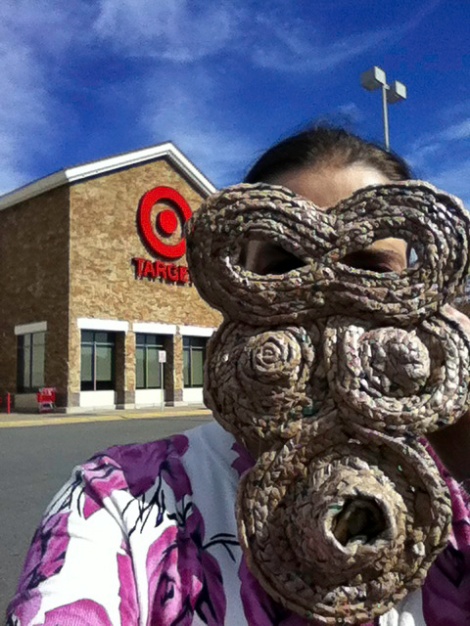Mask Project: The Infamous Sten Gustaf
The assignment is to identify one (free) found object and use that object to create a mask within the context of the found object. So I began this project by asking myself, what is the purpose of a mask? And how can I create a design to communicate the idea I’m considering?
A mask hides, but it also reveals. A mask can be ceremonial, entertaining, to disguise, or to anonymously make a statement about an idea. A mask removes the specific individual reference and can represent a gender-race-cultural-neutral idea without personal distractions. The mask can represent the idea of many people, in my case those concerned about consumer waste, as it affects individuals. I wanted to relate consumer waste, and the need for environmental protection awareness, into the theme of my mask design.
I drew several sketches before settling on the final design. Because I was only using one object as material for the mask, I wanted the design to include the strong graphic elements of repetition, pattern, and rhythm.
We as a worldwide culture have a toxic love affair with one-time use plastic shopping bags. Most people try to recycle them, some even repurpose them into other products, and a few strive to avoid them entirely by bringing their other paper or fabric bags. But the problem of this accumulating trash is enormous and has widespread impact to our environment.
From the beginning of the project, I knew I wanted to make an environmental statement, but until I had actually written some mind-mapping ideas, I didn’t have a clear vision of what direction I wanted to take with project.
Next, I brainstormed a list of potential waste materials, and eventually decided on using plastic shopping bags.
The object of my mask design, one-time-use plastic shopping bags, functions as a bridge to the discourse surrounding the controversy between ordinary daily routine and the larger concern regarding the permanent destruction to our environment and its subsequent impact to wildlife.
The mask design is based on ancient Indian Medicine Man masks. I like the idea of relating a sacred Indian object to the recklessness of disposable plastic bags in order to draw attention to the need for healing the environment, and our worldwide view, of the consequences of continued use of these bags.
I cut the bags into shreds, then braided them into strips, then sewed the strips into units, then combined the units into the final design. The process was quite invloved, and as it turns out, it is very difficut to sew plastic.
I incorporated an infinity sign around the eyes as a symbolic reference to the fact that the environment issues are ongoing without a remediation strategy. The infinity sign can also represent the evil snake eating it’s own head, as humans act irresponsibly with regard to treatment of the environment.
Sten Gustaf
So who is the infamous Sten Gustaf?
Gustaf is a Swedish engineer, who back in the 1950s, is credited with developing the technology to make plastic grocery bags. Poor Gustaf! We love his intervention for the very same reason we hate it (convenience, lightweight, indestructible, low cost, plentiful, etc.!)
Highlights of the One-Time-Use Plastic Shopping Bag:
- Worldwide use began in the 1960s
- US Consumption: 100+ billion bags annually (requiring 12 million barrels of oil)
- 500 million – 1 trillion annual worldwide use
- Wreaking environmental havoc everywhere on earth: growing plastic ocean “islands”, filling landfills, land litter cogging drains and surface water systems, life-threatening harm to wildlife.
- Pollution likely a larger problem outside the US, where laws in developing countries, is not as well enforced
I also wanted this project to send a positive message, and not simply make a statement critcizing the thoughtless, irresponsible wastefulness of its worlds’ citizens.
Not surprising, online searches revealed that many others share my views on the wastefulness of one-time plastic shopping bags. However, oddly enough, many of these sites, are promoting hand-made items, such as handbags, baskets, rugs, and you guessed it, more durable shopping bags! Although I applaud the social awareness, I have to wonder how effective this strategy really is. Afterall, as the ideal of repurposing plastic bags into other projects becomes more popular won’t the laws of supply and demand simply create a stroger need for a product that is better left not produced?
Some law makers have either initiated a “bag” tax or banned their use entirely. More good intentions gone awry! This doesn’t solve the problem, it only singles out, and punishes one particular industry, while ignoring all the other plastic products that pollute our environment. Specific business like Whole Foods and Ikea have jumped on the band wagon and created corporate policy against the use of plastic bags. But I think there are better solutions!
I think it makes more sense for legislators to incentivise industry, through development grants and tax benefits, to create a more earth friendly, bio-degradable product. This technology is available, but not yet widely used.
The ultimate goal for this project: I dream of a time when children will have no understanding of the question, “paper or plastic?”

